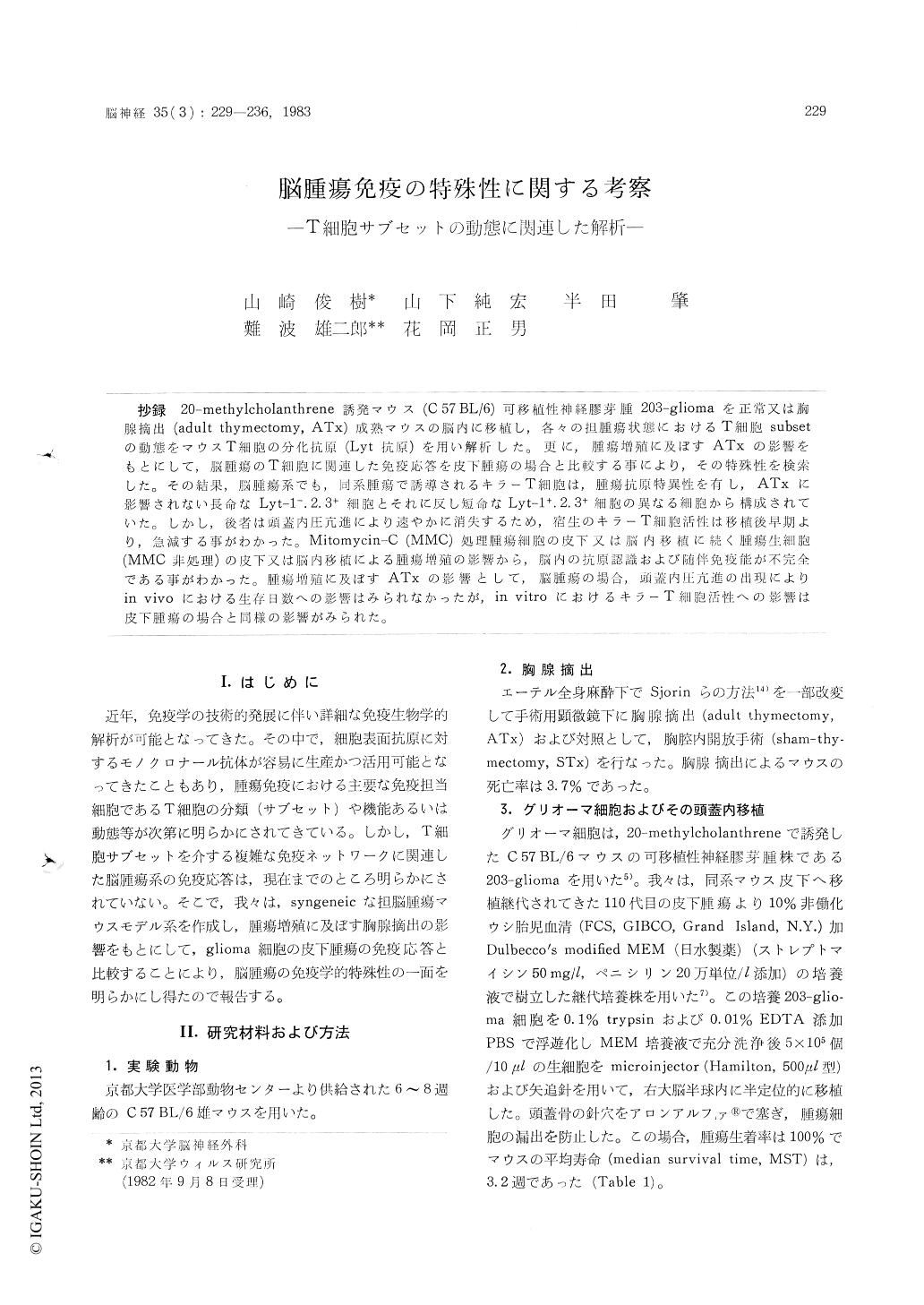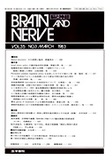Japanese
English
- 有料閲覧
- Abstract 文献概要
- 1ページ目 Look Inside
抄録 20—methylcholanthrene誘発マウス(C 57 BL/6)可移植性神経膠芽腫203—gliomaを正常又は胸腺摘出(adult thymectomy,ATx)成熟マウスの脳内に移植し,各々の担腫瘍状態におけるT細胞subsetの動態をマウスT細胞の分化抗原(Lyt抗原)を用い解析した。更に,腫瘍増殖に及ぼすATxの影響をもとにして,脳腫瘍のT細胞に関連した免疫応答を皮下腫瘍の場合と比較する事により,その特殊性を検索した。その結果,脳腫瘍系でも,同系腫瘍で誘導されるキラーT細胞は,腫瘍抗原特異姓を有し,ATxに影響されない長命なLyt−1—,2.3+細胞とそれに反し短命なLyt−1+.2.3+細胞の異なる細胞から構成されていた。しかし,後者は頭蓋内圧亢進により速やかに消失するため,宿生のキラーT細胞活性は移植後早期より,急減する事がわかった。Mitomycin-C (MMC)処理腫瘍細胞の皮下又は脳内移植に続く腫瘍生細胞(MMC非処理)の皮下又は脳内移植による腫瘍増殖の影響から,脳内の抗原認識および随伴免疫能が不完全である事がわかった。腫瘍増殖に及ぼすATxの影響として,脳腫瘍の場合,頭蓋内圧亢進の出現によりin vivoにおける生存日数への影響はみられなかったが,in vitroにおけるキラーT細胞活性への影響は皮下腫瘍の場合と同様の影響がみられた。
Immunological responses in relation to the ki-netics of killer T cell induction to intracranially transplanted syngeneic murine malignant glioma cells (20-methylcholanthrene-induced glioma, 203-glioma) were investigated in C57BL/6 mice in order to elucidate the peculiarity of immunological re-sponses to brain tumor.
Small dose of 203-glioma cells (1×105) unable to be taken in subcutaneous inoculation was taken in intracranial inoculation. The killer T cell activity of splenic cells, which was specific for 203-glioma cells and almost completely elimina-ted by the treatment with anti-Thy-1 monoclonal antibody and complement, began to be severely impaired 2 weeks after intracranial inoculation concurrently with the increased intracranial pres-sure due to developing tumor growth. On the other hand, the killer T cell activity of splenic cells was maintained for over 4 weeks in mice inoculated with mitomycin-C treated 203-glioina cells.
Follwing subcutaneous inoculation (at the dose of 9×105) of mitomycin-C treated 203-glioma cel-ls, viable 203-glioma cells were re-inoculated in-tracranially (1×105, 5×105) or subcutaneouslly (5×105, 1×106) 10 days later. In the former mice, each median survival time (MST) was 12.2 and 6.6 weeks and each tumor death rate in 8 weeks (TDR) was 44.4% and 100%. On the other hand in the latter mice tumor was not taken at the dose of 5×105 203-glioma cells and regressed 80 % at the dose of 1 x 106 203-glioma cells.
Following intracranial inoculation (at the dose of 5×105) of mitomycin-C treated 203-glioma cells, viable 203-glioma cells were re-inoculated intracranially (1×105, 5×105) or subcutaneously (5×105, 1×106) 10 days later. In the former mice, each MST was 8.8 and 5.6 weeks and each TDR was 90% and 100%. On the other hand, in the latter mice tumor was regressed 75% at the dose of 5×105 203-glioma cells. MST at the dose of 1×106 203-glioma cells was 10.8 weeks. Each TDR was 0% and 25%. These results strongly suggested that the concomitant immunity in brain tumor was generated incompletely and partially.
The surface markers of killer T cells were chec-ked with the results that in intracranial tumor-bearing mice Lyt-l-.2.3+ killer T cells were pre-dominant, whereas both Lyt-1-.2.3+ and Lyt-1+. 2.3+ killer T cells were equally mediated in sub-cutaneous tumor. Lyt-1+. 2.3+ killer T cells were thought to disappear rapidly in the presence of increased intracranial pressure.
The effect of adult thymectomy on in vivo and in vitro responses to 203-glioma were also investigated in order to analyse the role of T cell subpopulation in brain tumor. Median survi-val time (MST) in adult mice thymectomized 3 and 10 weeks before intractanial inoculation of tumor cells was not shorter than in sham-thymec-tomized controls. On the other hand, the killer T cell activity of splenic cells was increased in mice thymectomized 3 weeks before tumor cell inocu-lation and decreased in mice 10 weeks before tu-mor cell inoculation. In mice tymectomized 3 and 10 weeks before tumor cell inoculation, Lyt-1+. 2.3+ killer T cells were not detected in intra-cranial tumor as well as in subcutaneous tumor, suggesting that the progenitors of Lyt-1+. 2.3+ killer T cells are short-lived cells in contrast to those of Lyt-1-.2.3+ killer T cells which survive more than 10 weeks after adult thymectomy.
Accordingly, in intracranial tumor-bearing mice the recognition of tumor associated antigen and the generation of tumor specific killer T cells are partially impaired because of increased intracra-nial pressure in addition to the absence of the lymphatic pathway and the presence of the blood brain barrier

Copyright © 1983, Igaku-Shoin Ltd. All rights reserved.


